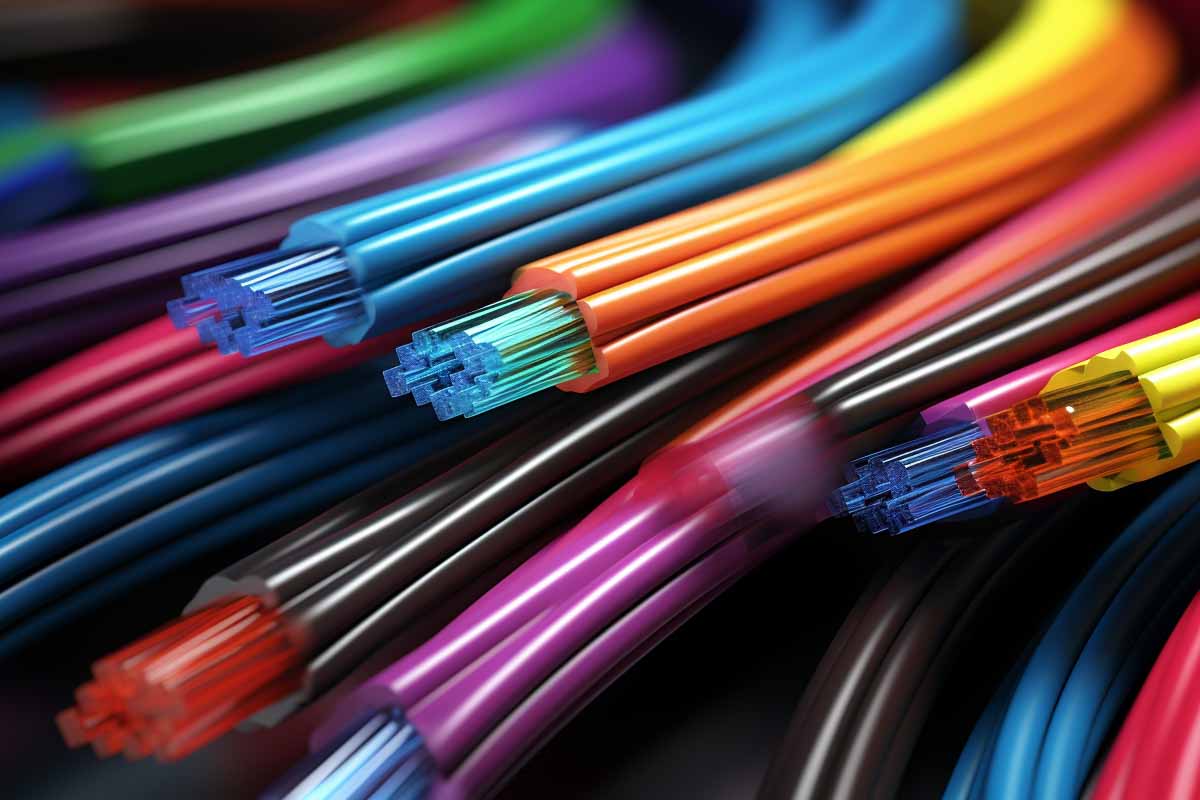Fiber optic cable types are at the core of modern communication technology. As a seasoned expert with 20 years of experience in the field, I’ve witnessed firsthand the evolution of these cables and their growing importance in connecting our world. In this comprehensive guide, we’ll explore the various fiber optic cable types, delve into their applications, and provide insights on how to select the best option for your network. Whether you’re a seasoned professional or new to the world of fiber optics, this article will equip you with the knowledge you need to make informed decisions.
II. Overview of Fiber Optic Cable Types
Definition and Basic Understanding
Fiber optic cables are a marvel of modern engineering, allowing for the transmission of data at the speed of light. These cables consist of thin strands of glass or plastic fibers that carry light signals over long distances. The fiber optic cable types vary in their construction, performance, and application, making them suitable for a wide range of uses.
Historical Development
The journey of fiber optic technology began in the early 1960s, and since then, it has undergone significant advancements. From the initial experiments with light transmission to the development of various fiber optic cable types, the field has seen tremendous growth. Today, fiber optics is an essential part of global communication infrastructure, enabling high-speed internet, television broadcasting, and more.

Perpare for CompTIA Network+ Certification
Learn concrete vendor neutral Network fundamentals in our comprehensive CompTIA Network+ traning course.
Importance in Various Industries
Fiber optic cable types are not just limited to telecommunications. They play a vital role in industries such as healthcare, where they are used in medical imaging, and in the military, where they provide secure communication channels. The adaptability and efficiency of fiber optic cables have made them indispensable in our technologically driven world.
III. Types of Fiber Optic Cables
Single-Mode Fiber Cables
Single-Mode Fiber (SMF) cables are one of the most common fiber optic cable types. They consist of a single strand of glass fiber with a narrow core, allowing only one mode of light to propagate. This design minimizes signal loss and allows for long-distance transmission, making SMF cables ideal for telecommunications and internet service providers.
Multi-Mode Fiber Cables
Unlike SMF cables, Multi-Mode Fiber (MMF) cables have a larger core, allowing multiple modes of light to travel simultaneously. This results in a higher data capacity but over shorter distances. MMF cables are commonly used in local area networks (LANs) and data centers, where high-speed data transfer is required within a confined space.
Specialty Fiber Cables
In addition to SMF and MMF cables, there are specialty fiber optic cable types designed for specific applications. These include polarization-maintaining fibers, photonic crystal fibers, and more. These specialty cables cater to niche requirements and are often used in scientific research, industrial applications, and other specialized fields.

Perpare for CompTIA Network+ Certification
Learn concrete vendor neutral Network fundamentals in our comprehensive CompTIA Network+ traning course.
IV. How to Select the Best Option
Understanding the Requirements
Selecting the right fiber optic cable type begins with understanding your specific needs. The requirements can be broadly categorized into two aspects:
- Long-Distance Transmission: If your network requires transmitting data over long distances without significant signal loss, Single-Mode Fiber (SMF) cables are the ideal choice. They are designed to carry a single light mode, minimizing interference and allowing for efficient long-range communication.
- High Data Capacity Over Short Distances: Multi-Mode Fiber (MMF) cables are suitable for situations where high data capacity is needed over shorter distances. With a larger core that allows multiple light modes, MMF cables are commonly used in local area networks (LANs) and data centers.
Understanding these fundamental differences between SMF and MMF cables, and aligning them with your specific needs, is the first step in selecting the right fiber optic cable types for your network.
Analyzing the Environment
The environment in which the cables will be installed plays a crucial role in selection. Here are some key factors to consider:
- Temperature: Extreme temperatures can affect the performance of fiber optic cables. Ensuring that the selected cables can withstand the environmental conditions is vital.
- Humidity: Moisture can cause degradation in fiber optic cables. Selecting cables with proper insulation and protection is essential in humid environments.
- Potential Interference: Electromagnetic interference from nearby electrical equipment can impact signal quality. Understanding the installation environment and choosing cables with proper shielding can mitigate this risk.
- Physical Constraints: Consideration of the physical layout, including bends, twists, and potential obstacles, will guide the selection of the most suitable fiber optic cable types.
Comparing the Costs
While performance is paramount, cost considerations cannot be overlooked. Here’s how to analyze the total cost of ownership:
- Initial Costs: This includes the cost of the cables themselves, installation, and any necessary equipment. Comparing different fiber optic cable types and vendors can help you find the best value.
- Maintenance Costs: Regular maintenance is essential for optimal performance. Consider the ongoing costs of inspection, cleaning, and repair.
- Potential Upgrades: Technology is constantly evolving, and future upgrades may be necessary. Understanding the potential costs of upgrading the cables or related equipment will provide a more accurate long-term cost assessment.
- Cost-Benefit Analysis: Weighing the performance benefits against the total costs will help you make an informed decision that aligns with both your technical requirements and budget constraints.
By carefully evaluating your requirements, analyzing the environment, and comparing the costs, you can select the fiber optic cable types that best meet your needs. This comprehensive approach ensures that your network is not only efficient and reliable but also cost-effective.
V. Applications and Use Cases
Telecommunications
Fiber optic cable types have revolutionized the telecommunications industry, providing the backbone for high-speed internet and telephone services. Their ability to transmit large amounts of data over long distances without significant loss makes them the preferred choice for global communication networks.
Internet and Networking
In the world of internet and networking, fiber optic cables offer unparalleled speed and reliability. Whether it’s connecting data centers or providing broadband services to homes, the various fiber optic cable types play a crucial role in ensuring seamless connectivity.
Medical and Military Applications
Specialized fiber optic cables are used in medical imaging, allowing for precise and non-invasive procedures. In the military, secure and robust communication is achieved through the use of specific fiber optic cable types, ensuring that vital information is transmitted safely.

Lock In Our Lowest Price Ever For Only $14.99 Monthly Access
Your career in information technology last for years. Technology changes rapidly. An ITU Online IT Training subscription offers you flexible and affordable IT training. With our IT training at your fingertips, your career opportunities are never ending as you grow your skills.
Plus, start today and get 10 free days with no obligation.
VI. Maintenance and Care
Proper Installation
The performance of fiber optic cables depends heavily on proper installation. Utilizing professional services and following industry standards is essential to avoid potential issues and ensure optimal functionality.
Regular Maintenance
Regular inspection and maintenance of fiber optic cables are vital to their longevity. This includes cleaning connectors, monitoring signal quality, and addressing any physical damages promptly.
Troubleshooting Common Issues
Understanding common issues with fiber optic cable types and how to troubleshoot them is essential for maintaining a healthy network. Whether it’s signal loss, connector problems, or cable breaks, having a systematic approach to identifying and resolving issues is key.
VII. Conclusion
Fiber optic cable types are an integral part of our connected world. From telecommunications to medical applications, they touch various aspects of our lives, enabling technologies that we often take for granted. Selecting the right type of fiber optic cable for your network requires careful consideration of factors such as requirements, environment, and cost. With 20 years of experience in the field, I can attest to the importance of making informed decisions and investing in proper maintenance to reap the benefits of this remarkable technology.
In a world that’s constantly evolving, fiber optic cables stand as a testament to human innovation and our relentless pursuit of connectivity. Whether you’re a seasoned professional or just beginning to explore the world of fiber optics, I hope this guide has provided valuable insights into the various fiber optic cable types and how to select the best option for your network.

Perpare for CompTIA Network+ Certification
Learn concrete vendor neutral Network fundamentals in our comprehensive CompTIA Network+ traning course.
Frequently Asked Questions About Fiber Optic Cable Types
What are the main fiber optic cable types, and how do they differ?
The main fiber optic cable types are Single-Mode Fiber (SMF) and Multi-Mode Fiber (MMF) cables. SMF cables have a narrow core and are used for long-distance transmission, while MMF cables have a larger core and are suitable for short distances with higher data capacity. Specialty fiber optic cable types are also available for specific applications.
How do I choose the right fiber optic cable types for my network?
Selecting the right fiber optic cable types requires understanding your specific needs, analyzing the environment, and comparing costs. Consider factors such as distance, data capacity, environmental conditions, and budget to make an informed decision.
Can fiber optic cable types be used in medical and military applications?
Yes, specialized fiber optic cable types are used in both medical and military applications. In healthcare, they enable precise medical imaging, while in the military, they provide secure communication channels.
What maintenance is required for different fiber optic cable types?
Proper maintenance of fiber optic cable types includes regular inspection, cleaning of connectors, monitoring signal quality, and addressing any physical damages promptly. The maintenance may vary slightly based on the specific type and application of the cable.
Are fiber optic cable types affected by weather conditions?
Fiber optic cable types are generally resistant to weather conditions, but extreme temperatures and humidity can affect performance. Proper installation and protective measures can mitigate these effects, ensuring optimal functionality.
























